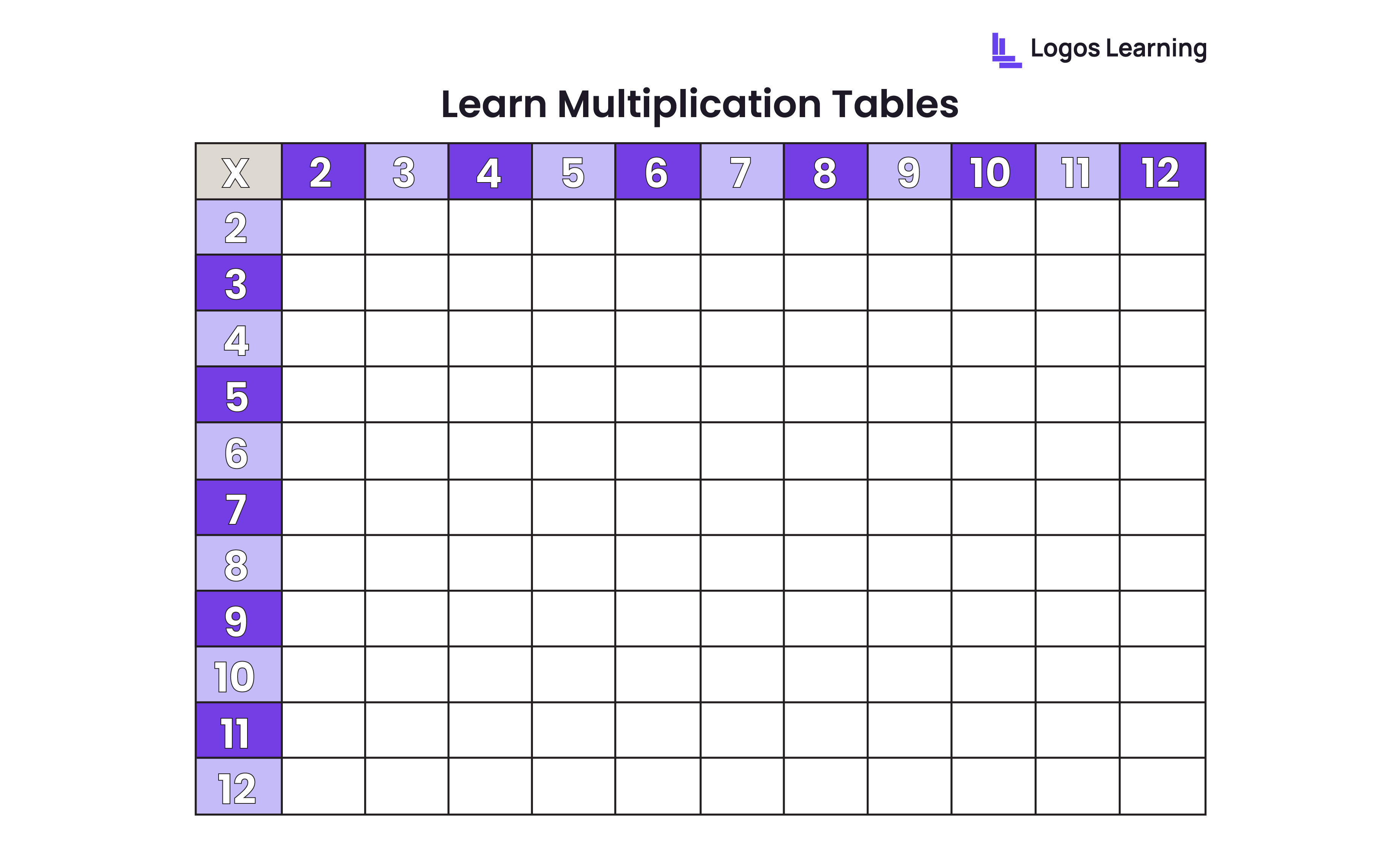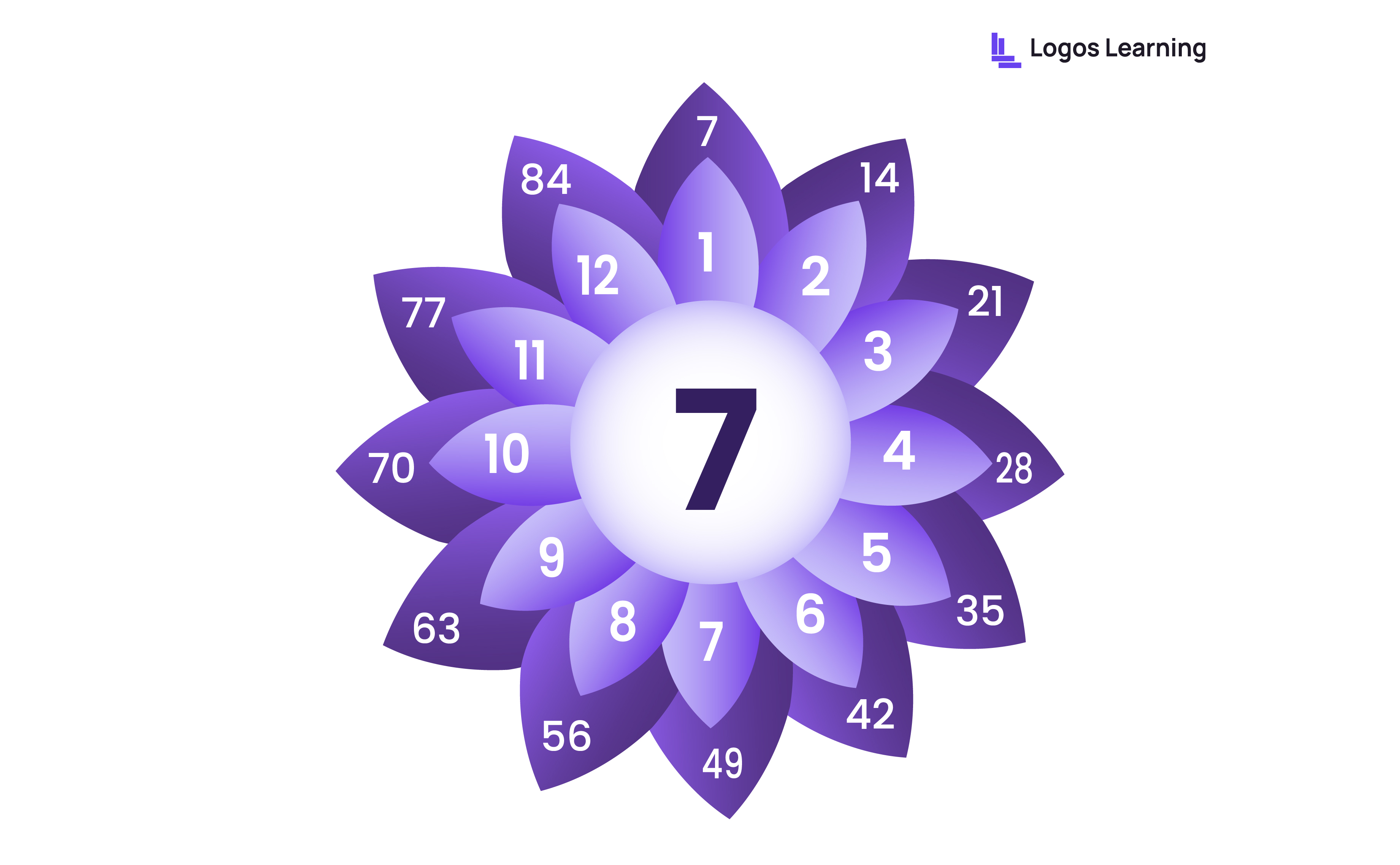
Learning multiplication tables can be a simple task. There are many simple and fun ways to learn multiplication tables. One of the best ways to learn multiplication tables is through repetition and practice using methods like flashcards, songs, or online games. Start with the easier tables like 2s, 5s, and 10s first, and then gradually work your way up. Connections between the tables and real-life examples can also help the numbers stick in your memory.
With regular practice using engaging techniques, even the trickiest multiplication tables will soon become second nature in elementary Maths . The key is to find the best way to learn multiplication tables that makes learning the tables enjoyable for kids. Exploring the different ways to learn multiplication tables and experimenting with various techniques can help the kids discover the approach that works best for their learning style in elementary Maths.
Multiplication tables, commonly known as times tables, are a set of basic math facts that show the product of two numbers. For example, in the "5 times table," you'll find equations like 5 × 1 = 5, 5 × 2 = 10, 5 × 3 = 15, and so on up to 5 x 12 = 60. These tables typically cover numbers 1 through 12, though some extend up to 20 times table. The 2 times table would be 2 x 1 = 2, 2 x 2 = 4, 2 x 3 = 6, and so forth. The 4 times tables starts with 4 x 1 = 4, 4 x 2 = 8, 4 x 3 = 12, and continues in that pattern.
Learning these basic multiplications is essential because they form the building blocks for more advanced math concepts and calculations. Without a solid grasp of the multiplication tables, it becomes challenging to tackle complex mathematical operations efficiently. Imagine trying to solve an algebra equation or calculate the area of a room without knowing your 6 times table or 9 times table by heart. It would be a time-consuming and error-prone process.
That's why learning multiplication tables is important for developing strong math skills and problem-solving abilities. It not only lays the foundation for higher-level math but also enhances mental math capabilities, which are handy in everyday life situations like estimating costs, splitting bills, or calculating discounts. Math times tables worksheets and practice are crucial for mastering these fundamental facts.
Multiplication tables form the basis for more complex mathematical concepts like algebra, division, and fractions. A strong grasp of these fundamental arithmetic operations paves the way for future success in higher-level mathematics.
Knowing multiplication tables by heart helps in quick mental calculations, a handy skill in everyday situations. Whether you're splitting a restaurant bill, estimating the cost of grocery items, or tackling word problems, mental math proficiency can save you time and effort.
Strong multiplication skills lead to better problem-solving abilities in math and real-life scenarios. Many practical problems involve multiplication, and being able to solve them efficiently can make a significant difference in various aspects of life.
In exams or daily life, knowing multiplication tables saves time that would otherwise be spent figuring out simple multiplications. This efficiency can be invaluable, especially in timed tests or situations where quick decision-making is required.
Ideally, children should start learning multiplication tables around the second or third grade (ages 7-9). This is when they've grasped addition and subtraction, making them ready to tackle multiplication.

Start your journey by creating or downloading a comprehensive times table sheet. These visual aids are incredibly helpful. You can download a beautifully designed, easy-to-read sheet from Logos Learning, which covers tables from 1 to 12 or even up to 20. Having this sheet handy makes learning and revision much easier. For example, you can laminate the sheet and use a dry-erase marker to practice writing the tables repeatedly.
Begin with the simplest tables: 1s, 2s, 5s, and 10s. These are the easiest to learn and provide a confidence boost. The 1s table is straightforward (any number times 1 is that number itself). For 2s, it's like adding the number to itself (2 x 3 = 3 + 3 = 6). 5s end in 0 or 5 (5 x 6 = 30), while 10s always end in 0 (10 x 7 = 70). Mastering these basic times tables will lay a solid foundation for learning more complex ones.
Music is a powerful memory aid. Many educational platforms offer multiplication table songs set to popular tunes. These catchy melodies make learning fun and help facts stick in long-term memory. YouTube and educational websites are treasure troves for such songs. For example, you can find the "3 Times Table" song set to the tune of "Baa Baa Black Sheep."

This creative approach turns math into art. Draw a flower with petals numbered 1 to 12. In the center, write a number like 7. Multiply 7 with each petal number and write the result on the petal. This visual, hands-on method is particularly effective for visual learners. It can also be a fun group activity for classrooms or families.
Short, frequent quizzes reinforce learning. Use flashcards, and apps, or simply ask questions during daily activities like car rides. These mini-tests help identify which tables need more practice and build speed. For example, you could have a "Question of the Day" during breakfast or create a weekly quiz routine.
Learning tables requires effort, so celebrate achievements! Set goals (like mastering the 7s table) and offer rewards—stickers, extra screen time, or a special treat. This positive reinforcement boosts motivation and makes learning a positive experience. You could even create a progress chart or multiplication table checklist to track their milestones.
Relate multiplication to everyday situations kids can relate to, such as counting coins, sharing snacks, or organizing toys. This approach makes the abstract concept more concrete and practical, aiding better understanding and retention. For instance, if you're sharing 3 bags of cookies among 6 friends, how many cookies will each friend get? (3 x 6 = 18, so each friend gets 3 cookies).
By combining these methods and making learning an enjoyable and interactive experience, kids can master multiplication tables quickly and develop a solid mathematical foundation.
A powerful technique to make multiplication tables stick is to associate each fact with a vivid, relatable mental picture. Instead of just memorizing abstract numbers, create visual stories in your mind that connect the numbers to familiar objects or experiences.
For example, to remember 6 x 8 = 48, imagine 6 boxes with 8 donuts in each box. Picture the boxes piled up, and visualize counting all 48 delicious donuts. The silly image makes an impression and gives meaning to the math fact.
Or for 7 x 5 = 35, think of your hands and feet - you have 5 digits on each hand and 5 on each foot. In total, your hands and feet have 7 sets of 5 digits, making 35 in all.
The more personal and imaginative the connections, the better they'll stick. Link 9 x 6 to your age when you were 54 (9 years x 6 years). Or envision 4 x 9 puffy clouds each carrying 9 balloons.
While there are many effective ways to learn multiplication tables, some methods can be counterproductive:
In our fast-paced world, where calculators are always at hand, some might question the need to learn multiplication tables. However, this fundamental skill does more than help with math problems—it sharpens the mind, boosts confidence, and lays a solid foundation for future learning. The rewards stretch far beyond the math classroom, equipping learners with skills that will serve them throughout their lives.
Mastering multiplication tables helps develop critical thinking, problem-solving abilities, and a strong understanding of numerical relationships. It also enhances mental agility, concentration, and memory retention. These cognitive benefits extend to various aspects of life, from academic pursuits to practical tasks.
Mastering multiplication tables doesn't have to be a daunting task. By employing a variety of engaging, student-centered methods, you can make learning multiplication tables not just effective but genuinely enjoyable.
Remember, every child learns differently. Some might love the rhythm of songs, while others prefer the tactile experience of drawing visuals. The key is to experiment with different approaches until you find what works best. And always, always make it fun. When learning is enjoyable, knowledge sticks.
Start with the basics, build confidence, and gradually move to more challenging tables. Use downloadable worksheets as your trusty companion. Celebrate every achievement, no matter how small. With patience, creativity, and the right techniques, your child (or you!) will be multiplying like a math whiz in no time. The easiest way to learn multiplication tables is through a combination of these methods, making learning multiplication tables an enjoyable and interactive experience.
Logos Learning, an online tutoring platform, provides online math tutors who are experts in teaching multiplication tables. They offer personalized guidance, engaging activities, and a supportive learning environment to help students master this essential skill with ease and confidence. Games to learn multiplication tables and fun ways to learn multiplication tables are incorporated into their curriculum to help students master this essential skill with ease and confidence.
1. How long does it typically take to master all multiplication tables?
With consistent practice using engaging methods like songs, games, or flashcards, many children can become fluent in all multiplication tables up to 12x12 within 4-6 months. However, the timeline depends on factors like age, prior skills, learning style, and dedicated practice time.
2. Should I let my child use tricks like the multiplication fingers method?
While tricks can help initially, the goal should be memorizing the facts automatically without relying on external aids. Overuse of tricks may hinder true mastery. Use them as stepping stones, but balance appropriately as your child progresses.
3. What are good strategies for memorizing multiplication facts?
Use active, multisensory methods like chanting with motions, manipulatives for arrays, math games/apps, and frequent quizzing with flashcards or drills. Making practice interactive, varied, and even competitive can boost retention. Consistent review is key.